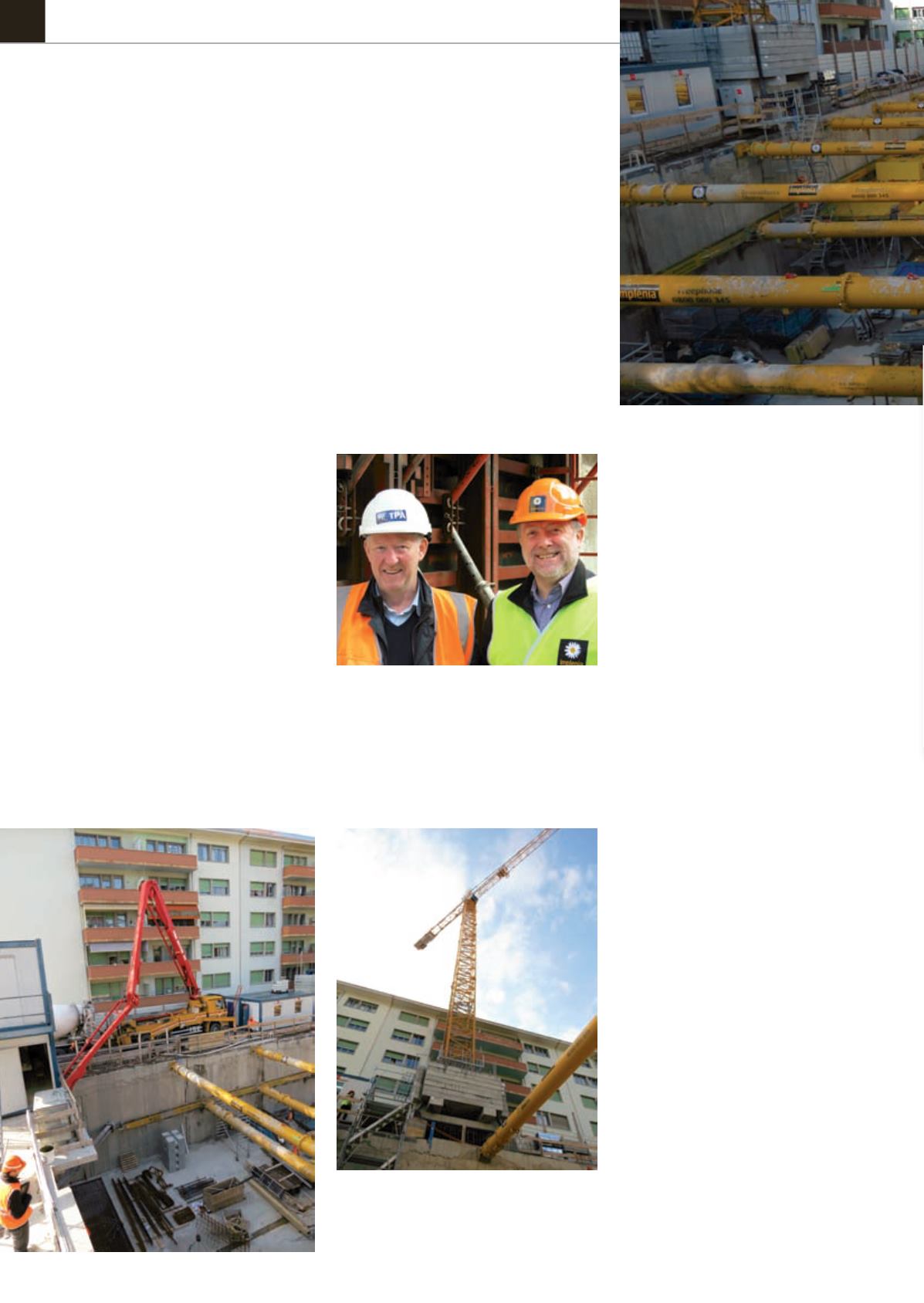
IRN NOVEMBER-DECEMBER 2013
46
SITE VISIT GROUNDFORCE
Something
different
An unassuming apartment block project on the outskirts of
Geneva is helping UK rental company Groundforce introduce its
hydraulic shoring technology to the European market. Murray
Pollok reports from Switzerland.
they already own the steel.
At the Chene-Bourg site, however, space is at a
premium, with the site bounded on one side by a
busy road and on one of its long edges by an existing
apartment building. So cramped, in fact, that the
project offices have to be cantilevered over the
excavation.
“It is a very difficult site and it will continue to
be a difficult site until the end of the job”, says Mr
Binétruy.
The block comprises seven storeys, including three
basement levels to a depth of 12 m below ground
level. This required a 0.6 m thick concrete diaphragm
wall enclosing the entire 26 m by 80 m site.
Normally, Implenia, working with earthworks
contractor HTP, would have progressively installed
a steel shoring frame - anchored at the walls and
with intermediate vertical columns placed on piles
in the base of the excavation. This frame would
have comprised a dense latticework of horizontal,
longitudinal and vertical beams, making it difficult
for the main building contractor Belloni to progress
with the internal concrete walls and flooring slabs.
Instead, Implenia decided to try out hydraulic
struts, a system that it first saw at a foundations
exhibition in Piacenza, Italy, in 2012 where it was
being displayed by Groundworks, the trenching
equipment division of UK rental company VP plc.
Design partnership
VP's Groundworks, which rents an array of trenching,
shoring and piling products as well as the more
sophisticated hydraulic struts, worked with Implenia
and civil engineering design engineer ESM & Fiechter
Ingenieries to come up with a design for the project.
This comprised two sets of eight struts, the lower
struts using Groundforce’s 250 t capacity MP250
units and the upper set comprising smaller, 125 t
capacity MP125 units.
All 16 run in the same direction, with ample spacing
between each vertical pair to allow for lowering of
formwork panels and other building materials.
The struts were installed two at a time by Implenia,
starting in mid-June, while the earthworks contractor
used a Komatsu PC240LC with long digging arm -
rented from French company ENCO - to excavate the
clay. The struts were successfully removed in mid-
November.
Mr Binétruy says the Groundforce struts would not
be appropriate for simple excavation jobs, but in this
case, the density of the steel frame structure would
have made it very difficult for the contractor.
“There are two ways of seeing the time benefits”,
he says, “For the contractor it has saved something
like a week. And for us, it has taken just 20% of the
T
he private apartment block currently being
built at Chêne-Bourg in the suburbs of Geneva
will not – by the time the first residents have
moved in by late 2014 – appear any different from the
many others surrounding it.
If unremarkable in appearance, what does single
it out as something a bit different is the technique
used to shore up the deep excavation during
construction – a set of 16 hydraulic shoring struts in
two layers stretching across the 26 m wide site.
These massive struts – 0.61 m in diameter on the
bottom layer and 0.51 m on the top – support the
12 metre deep excavation over its full 80 m length
and are being used in place of traditional temporary
steel frame shoring. It is the first time that the Swiss-
based contractor Implenia has used the system and
also its first application in Switzerland.
Jean-Pierre Binétruy, geotechnical engineer and
project manager at Implenia’s foundations division,
tells
IRN
that the company normally favours the tried
and tested structural steel frames, in part because
they know how to do it that way, but also because
Sixteen shoring struts, in two layers, span the 26 m wide site
along its full 80 m length.
A base slab being poured from a concrete pump placed along the
edge of the cramped site.
Groundforce installed load sensors on the struts under the tower
crane. These struts are under the highest loadings.
David Williams, managing director of Groundforce (left), with
Peter Richardson, Groundforce’s consultant in Europe.


